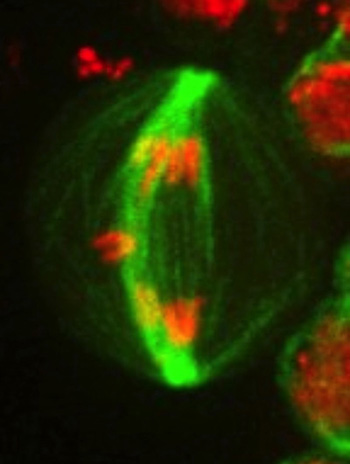Campus News
‘Hail Mary’ mechanism can rescue cells with severely damaged chromosomes
Understanding the mechanisms involved in chromosome repair, and how they can fail, may lead to new strategies to combat cancer.


The DNA vital to the life of a cell is packaged in chromosomes, and a variety of checkpoints, repair mechanisms, and other cellular safeguards exist to maintain the integrity of the chromosomes during cell growth and division. Those safeguards can fail, however, and a cell may find itself trying to divide into two daughter cells with a loose chromosomal fragment drifting away from a broken chromosome.
William Sullivan calls this a “worst case scenario” for the cell. The potential consequences include cell death or a cancerous cell growing out of control. But Sullivan, a professor of molecular, cell, and developmental biology at UC Santa Cruz, has found that the cell still has one more trick up its sleeve to rescue the broken chromosome.
The latest findings from Sullivan’s lab, published in the June 5 issue of Journal of Cell Biology, reveal new aspects of a remarkable mechanism that carries broken chromosomes through the process of cell division so that they can be repaired and function normally in the daughter cells. Sullivan has been studying this process in the fruit fly Drosophila melanogaster. His lab has created a strain of flies in which broken chromosomes are common due to the expression of a DNA-cutting enzyme.
“We have flies in which 80 percent of the cells have double-strand breaks in the DNA, and the flies are fine,” he said. “The cell has this amazing mechanism, like a Hail Mary pass with time running out.”
DNA tether
The mechanism involves the creation of a DNA tether which acts as a lifeline to keep the broken fragment connected to the chromosome. Powerful new microscopy techniques enable researchers to observe the whole process in living cells, with bright fluorescent tags highlighting the chromosomes and other cellular components.
When a cell divides, it duplicates its chromosomes to make one set for each of the daughter cells. The membrane around the nucleus, which keeps the chromosomes separate from the rest of the cell, breaks down. The two sets of chromosomes then line up and segregate to opposite sides of the cell, pulled apart by a structure of microtubules called the spindle. A new nuclear envelope forms around each set of chromosomes, and new cell membranes separate the two daughter cells.
Sullivan’s research has shown that chromosome fragments don’t segregate with the rest of the chromosomes, but get pulled in later just before the newly forming nuclear membrane closes. “The DNA tether seems to keep the nuclear envelope from closing, and then the chromosome fragment just glides right in at the last moment,” Sullivan said.
Genetic rearrangements
If this mechanism fails, however, and the chromosome fragment gets left outside the nucleus, the consequences are dire. The fragment forms a “micronucleus” with its own membrane and becomes prone to extensive rearrangements of its genetic material, which can then be reincorporated into chromosomes during the next cell division. Micronuclei and genetic rearrangements are commonly seen in cancer cells.
“We want to understand the mechanism that keeps that from happening,” Sullivan said. “We are currently identifying the genes responsible for generating the DNA tether, which could be promising novel targets for the next generation of cancer therapies.”
Sullivan has just received a new four-year, $1.5 million grant from the National Institute of General Medical Sciences to continue this research.
Graduate student Travis Karg is first author of the new paper, which shows that spindle microtubules play an important role in driving the delayed segregation of chromosome fragments. The other coauthors, in addition to Sullivan, are Mary Williard Elting and Sophie Dumont at UC San Francisco and Hannah Vicars at UC Santa Cruz. This work was supported by grants from the National Institutes of Health.